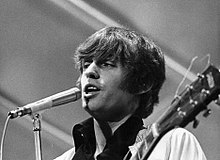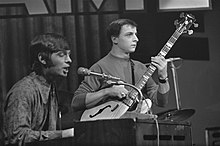Georgie Fame and the Blue Flames
Georgie Fame and the Blue Flames | |
|---|---|
 Lead vocalist Georgie Fame in Stockholm 1968 | |
| Background information | |
| Also known as | The Blue Flames |
| Origin | Britain |
| Genres | |
| Past members |
|
Georgie Fame and the Blue Flames were a British rhythm and blues group during the 1960s whose repertoire spanned R&B, pop, rock and jazz.
They were originally the backing band for rock and roll singer Billy Fury.
At the end of 1961, their piano player Georgie Fame took over as lead vocalist and they went on to enjoy great success without Fury. They were influenced by Jon Hendricks, Mose Allison and blues musicians such as Willie Mabon.
The group found other influences in ska, which could be heard in Jamaican cafes in and around Ladbroke Grove, England, and frequented by the group's Jamaican born trumpeter Eddie Thornton. During the group's three-year residency at The Flamingo Club, Fame heard the latest jazz and blues from America, and it was Booker T. & the M.G.'s recording "Green Onions" which inspired him to take up playing Hammond organ with the band.[1]
History
Formation
Georgie Fame (then known as Clive Powell) and Colin Green had worked together in 'Colin Green's Beat Boys', who had backed Gene Vincent and Eddie Cochran during UK tours. In 1961, piano player Fame, drummer Red Reece, bassist Tex Makins and Green were hired by pop manager Larry Parnes to back Billy Fury as the Blue Flames. Fury's manager dismissed them in February 1962 as he felt they were "too jazzy" and replaced them with the Tornados.
1961–1963
In December 1961, Alan "Earl" Watson fronted the Blue Flames, playing tenor saxophone and singing. In May 1962, the group was augmented by Ghanaian percussionist Neeomi "Speedy" Acquaye and Green left the group. Fame took over as the lead vocalist, Green was replaced by Joe Moretti and in turn was later replaced by John McLaughlin. During that time Rod "Boots" Slade had taken over as bass player while Makins toured with Johnny Hallyday. Saxophonist Mick Eve joined the group during 1962 and eventually the line up was completed by Johnny Marshall.
McLaughlin departed in April 1963 when he joined The Graham Bond Organisation, leaving the group without a guitarist for 18 months and during this period Rik Gunnell took over the management of the band.[2] In September 1963, they recorded their debut album Rhythm and Blues at the Flamingo which was produced by Ian Samwell, engineered by Glyn Johns[3] and released on the Columbia label.
1964–1966

Rhythm and Blues at the Flamingo failed to enter the UK chart, as did the single "Do the Dog" which was taken from this album and released in 1964. Two other singles, "Do Re Mi" and "Bend a Little", were also released during 1964, achieving no commercial success.[4]
In July 1964, Peter Coe replaced Marshall and was soon joined by baritone saxophonist Glenn Hughes and trumpet player Eddie "Tan-Tan" Thornton who had previously appeared occasionally with them[5][6][7] and Green rejoined the group in October 1964.
Reece became ill in 1964 and was replaced by Tommy Frost. Jimmie Nicol spent a brief period as drummer, then left to replace Ringo Starr for 13 days on a Beatles tour.[8] Phil Seamen and Micky Waller sat in for Nicol until Bill Eyden became the band's full-time drummer in September 1964.
In October 1964, the album Fame at Last reached No.15 in the U.K. album chart. The band's version of the song "Yeh, Yeh" was released as a single in the U.K. on 14 January 1965 and reached No.1 on the U.K. Singles Chart for two weeks (out of a total of twelve weeks on the chart).
The song "In the Meantime" was released as a single in February 1965 and reached the U.K. Top Twenty, however the band's next two single releases were not chart entries. Success followed with Fame's self penned song Get Away (released on 17 June 1966),[9] which climbed to the top of the UK chart for a solitary week in late-July. The song was originally written as a jingle for a television petrol advertisement (National filling stations).[10] It was later used as the theme tune for a long-running travel and lifestyle show on Australian television called Getaway. The two subsequent singles, "Sunny" and "Sitting in the Park" reached chart positions of No. 13 and No. 12 respectively. After the album Sweet Thing (1966) was released, Fame signed to CBS and became a solo artist.[4]
Eyden and Makins remained as the group's rhythm section until they were replaced in December 1965 by Cliff Barton and Mitch Mitchell. That lineup recorded the album Sweet Things, then on 1 October 1966 Fame disbanded the Blue Flames to pursue a solo career. Within a week Mitchell had been selected over Aynsley Dunbar to be the third member of what would be called The Jimi Hendrix Experience.[11]
Concert and appearances
The group were resident at a number of London clubs including The Whiskey-A-Go-Go, in Soho's Wardour Street[12] and the Flamingo Club.[13] In August 1963 the band took a weekly Friday night spot at The Scene on Great Windmill Street. They also performed at The Roaring Twenties club near Carnaby Street, run by Count Suckle. They did 22 midweek gigs at Klooks Kleek in 1964/65, The Ricky Tick in Windsor and The Scene, during week days.[11]
In 1964, Fame and the band appeared on five episodes of ITV's Ready Steady Go![14] Fame also appeared on television in 1965 in the New Musical Express Poll Winners' Concert held at the Empire Pool, Wembley on 11 April 1965, playing "Yeh, Yeh" and Rufus Thomas's "Walking the Dog".[15]
Georgie Fame and the Blue Flames were the only act from the UK invited to perform with the first Motown Review in the UK during the mid-1960s. The Tamla Motown Package Show was a 21-date UK tour featuring amongst others, the Supremes, Stevie Wonder and Martha Reeves & the Vandellas.
On 26 December 1966, Fame, backed by the Blue Flames, opened the "Fame in '67' Show" alongside Cat Stevens and the show ran for two weeks at London's Saville Theatre.[16]

In later years Fame was billed again with the Blue Flames and in the early 2000s he led a new line-up which included his son.[17]
Georgie Fame and the Aussie Blue Flames
Georgie Fame and the Aussie Blue Flames | |
|---|---|
| Also known as | The Thrill Seekers |
| Origin | Australia |
| Genres | Jazz |
| Past members | (see list) |
Fame ventured to Australia annually from 1977 to 1988 in order to play his music, and escape the English winter. Speaking to Kate Deamer of The Sydney Morning Herald, he explained that "there are several attractions to coming over, not least of which is the climate. Also, I've now got a very warm relationship with Australian musicians and look forward to coming out each year to play with them".[18] Each year an all-Australian backing band was hired to accompany Fame on tour, who were "top Sydney Jazz musicians".[19] For the 1980 tour, they were called the Thrill Seekers, and were led by a front line of Keith Stirling (trumpet), Col Loughnan (saxophones, flute), and Herb Cannon (trombone) with Steve Murphy (guitar), Greg Lyon (bass), and Willie Qua (drums) completing the line-up.[19]
The next year the band changed their name to the Aussie Blue Flames, and Charlie Gould was the guitarist. Over the years, the band featured Dave Coulton (guitar, 1983),[20] and Bob Johnson (trombone, 1987–88).[21] In September 1988, Fame seconded the Aussie Blue Flames to Albert Studios in Sydney to record the album No Worries, borrowing from the Australian habit of saying "No worries" often. The musician credits were:
- Georgie Fame – vocals, keyboards
- Keith Stirling – flugelhorn, trumpet
- James Greening – trombone
- Col Loughnan – saxophone, flute
- Jimmy Doyle – guitar
- Greg Lyon – bass
- Russell Dunlop – drums
- Sunil D'Silva – percussion
The album was released in 1988, under the name "Georgie Fame" with no mention of the Aussie Blue Flames, on the Swedish label Four Leaf Clover.[22] Paul Speelman of The Age praised the touring band in 1988, saying, "One would be hard put to find many better combos in the world than this particular sextet of Aussie Blue Flames."[21] Fame continued to tour in Australia until 2006; however the visits were more sporadic than before 1988.
Popular culture
Two of the band's recordings, "Pink Champagne" and "Yeh, Yeh", were featured in the 2020 Netflix series 'The Queen's Gambit'.
Discography
- and the Blue Flames
References
- ^ "It was a great place to play, a midnight to 6am thing on Fridays and Saturdays and it was full of American GIs who came in from their bases for the weekend. They brought records with them and one of them gave me "Green Onions" by Booker T & the MG's. I had been playing piano up to that point but I bought a Hammond organ the next day."Rik Gunnell, Club owner and impresario: obituary by Spencer Leigh at independent.co.uk
- ^ "Georgie Fame reminisces with Jamie Cullum about his Flamingo Club days". youtube.com. 8 May 2013. Archived from the original on 15 December 2021. Retrieved 11 December 2014.
- ^ Johnny Gunnell. Cover liner notes for Rhythm and Blues at the Flamingo, Polydor RSO, SPELP80.
- ^ a b "Georgie Fame | Music Biography, Credits and Discography". allmusic.com. Retrieved 30 July 2014.
- ^ "Neemoi 'Speedy' Acquaye info (The Musicians' Olympus)". Reocities.com. Retrieved 30 July 2014.
- ^ "The Story. Your 60s site since 1998". Billy Fury. Archived from the original on 10 June 2008. Retrieved 30 July 2014.
- ^ "Memories". Colingreen.co.uk. Retrieved 30 July 2014.
- ^ Mastropolo, Frank (3 June 2015). "13 Days as a Beatle: The Sad History of Jimmie Nicol". ultimateclassicrock.com.
- ^ "Georgie Fame Biography". IMDb.com. Retrieved 30 July 2014.
- ^ "UKMIX – Articles - Chart Of All Time – 1966". ukmix.org. Retrieved 10 January 2015.
- ^ a b Maycock, James (16 January 1998). "Pop music: Fame at the Flamingo: golden years in Soho – Life and Style". The Independent. Retrieved 30 July 2014.
- ^ Rudland, D. (2010), CD booklet notes to Georgie Fame: Mod Classics 1964–1966, Ace Records, CDBGPD 206
- ^ [1] Archived 15 July 2011 at the Wayback Machine
- ^ "The Ballad of Bonnie and Clyde – Georgie Fame & the Blue Flames – Major Performers in Rock And Pop Music – Epinions.com". 9.epinions.com. Archived from the original on 11 August 2014. Retrieved 30 July 2014.
- ^ [2] Archived 21 December 2010 at the Wayback Machine
- ^ "Cat Stevens – Year To Year Time Line". Majicat. Retrieved 30 July 2014.
- ^ "Georgie Fame". Making Time. Retrieved 30 July 2014.
- ^ Deamer, Kate (2 January 1987). "Sweet Georgie comes back to The Basement" The Sydney Morning Herald John Fairfax and Co. Retrieved 12 April 2015.
- ^ a b Myers, Eric (18 November 1980). "The timeless excellence of Fame" The Sydney Morning Herald John Fairfax and Co. Retrieved 12 April 2015.
- ^ Lin, David (12 January 1983). "Georgie Fame captivates his audience" The Sydney Morning Herald John Fairfax and Co. Retrieved 18 April 2015.
- ^ a b Speelman, Paul (19 January 1988). "Spirited Fame fans the musical flames" The Age John Fairfax and Co. (Melbourne). Retrieved 18 April 2015. Note: after clicking on the link to the article, navigate to the right to view the correct article.
- ^
No worries (LP album notes). Georgie Fame. Four Leaf Clover Records. 1988. ASIN B0083L40WC.
{{cite AV media notes}}: CS1 maint: others in cite AV media (notes) (link)
